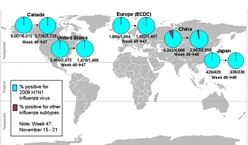You are subscribed to updates from the Centers for Disease Control and Prevention (CDC).
CDC H1N1 Flu Website Situation Update, November 30, 2009
Key Flu Indicators
Each week CDC analyzes information about influenza disease activity in the United States and publishes findings of key flu indicators in a report called FluView. During the week of November 15-21, 2009, influenza activity decreased in some key indicators and increased in others. Overall influenza activity remains high for this time of year. Below is a summary of the most recent key indicators:
- Visits to doctors for influenza-like illness (ILI) nationally decreased sharply this week over last week with all regions showing declines in ILI. This is the fourth consecutive week of national decreases in ILI after four consecutive weeks of sharp increases While ILI has declined, visits to doctors for influenza-like illness remain high.
- Influenza hospitalization rates remain higher than expected for this time of year. Hospitalization rates continue to be highest in younger populations with the highest hospitalization rate reported in children 0-4 years old.
- The proportion of deaths attributed to pneumonia and influenza (P&I) based on the 122 Cities Report continues to be higher than expected for this time of year. This proportion has remained elevated for eight weeks now. In addition, 35 flu-related pediatric deaths were reported this week: 27 of these deaths were associated with laboratory confirmed 2009 H1N1; 7 were influenza A viruses, but were not subtyped and one death was associated with a seasonal influenza A (H1) virus. The one death associated with seasonal influenza A (H1) virus infection reported this week actually occurred in March, during the 2008-09 season. Since April 2009, CDC has received reports of 234 laboratory-confirmed pediatric deaths: 198 due to 2009 H1N1, 35 pediatric deaths that were laboratory confirmed as influenza, but the flu virus subtype was not determined, and one pediatric death associated with a seasonal influenza virus. (Laboratory-confirmed deaths are thought to represent an undercount of the actual number. CDC has provided estimates about the number of 2009 H1N1 cases and related hospitalizations and deaths.)
- Thirty-two states are reporting widespread influenza activity at this time; a decline of 11 states from last week. They are: Alabama, Alaska, Arizona, California, Connecticut, Delaware, Florida, Idaho, Illinois, Indiana, Kansas, Kentucky, Maine, Maryland, Massachusetts, Michigan, Nevada, New Hampshire, New Jersey, New Mexico, New York, North Carolina, Ohio, Oklahoma, Oregon, Pennsylvania, Rhode Island, Tennessee, Utah, Vermont, Virginia, and West Virginia).
- Almost all of the influenza viruses identified so far continue to be 2009 H1N1 influenza A viruses. These viruses remain similar to the virus chosen for the 2009 H1N1 vaccine, and remain susceptible to the antiviral drugs oseltamivir and zanamivir with rare exception.
*All data are preliminary and may change as more reports are received.
U.S. Situation Update
U.S. Patient Visits Reported for Influenza-like Illness (ILI)

U.S. Influenza-like Illness (ILI) Reported by Regions

|
Cases Defined by
|
Hospitalizations
|
Deaths
|
|
|---|---|---|---|
| Influenza Laboratory-Tests** | 29,348 | 1,224 | |
|
*Reports can be based on syndromic, admission or discharge data, or a combination of data elements that could include laboratory-confirmed and influenza-like illness hospitalizations. *Laboratory confirmation includes any positive influenza test (rapid influenza tests, RT-PCR, DFA, IFA, or culture), whether or not typing was done. The table shows aggregate reports of all laboratory confirmed influenza hospitalizations and deaths (including 2009 H1N1 and seasonal flu) since August 30, 2009 received by CDC from U.S. states and territories**. This table will be updated weekly each Friday at 11 a.m. For the 2009-2010 influenza season, states are reporting based on new case definitions for hospitalizations and deaths effective August 30, 2009. CDC will continue to use its traditional surveillance systems to track the progress of the 2009-2010 influenza season. For more information about influenza surveillance, including reporting of influenza-associated hospitalizations and deaths, see Questions and Answers: Monitoring Influenza Activity, Including 2009 H1N1. The number of 2009 H1N1 hospitalizations and deaths reported to CDC from April – August 2009 is available on the Past Situation Updates page. For state level information, refer to state health departments. International Human Cases of 2009 H1N1 Flu Infection
**States report weekly to CDC either 1) laboratory-confirmed influenza hospitalizations and deaths or 2) pneumonia and influenza syndrome-based cases of hospitalization and death resulting from all types or subtypes of influenza. Although only the laboratory confirmed cases are included in this report, CDC continues to analyze data both from laboratory confirmed and syndromic hospitalizations and deaths. |
|||
|
Date Reported
|
Laboratory-Confirmed 2009 H1N1 Influenza Pediatric Deaths
|
Laboratory-Confirmed Influenza A Subtype Unknown Pediatric Deaths
|
Laboratory-Confirmed
Seasonal Influenza |
Total |
|---|---|---|---|---|
| This Week (Week 46, November 15-21, 2009) | 27 | 7 | 1 | 35 |
| Since August 30, 2009 | 140 | 32 | 0 | 172 |
| Cumulative since April 26, 2009 | 198 | 35 | 1 | 234 |
|
This table is based on data reported to CDC through the Influenza-Associated Pediatric Mortality Surveillance System. Influenza-associated deaths in children (persons less than 18 years) was added as nationally notifiable condition in 2004. For more information about influenza-associated pediatric mortality, see FluView. |
||||
For more information about the U.S. situation, see the CDC H1N1 Flu U.S. Situation page.
International Situation Update
 This report provides an update to the international situation as of November 30, 2009. The World Health Organization (WHO) continues to report laboratory-confirmed 2009 H1N1 flu cases and deaths on its Web page. These laboratory-confirmed cases represent a substantial underestimation of total cases in the world, as many countries focus surveillance and laboratory testing only on people with severe illness. The 2009 H1N1 influenza virus continues to be the dominant influenza virus in circulation in the world. From April 19 to November 14, 2009, 70.5% of influenza
specimens reported to WHO were 2009 H1N1 viruses and from November 8 to November 14, 2009, 89.4% of influenza specimens reported to WHO were 2009 H1N1. In temperate regions of the Southern Hemisphere, little disease activity due to 2009 H1N1 has been reported. In tropical regions of the Americas and Asia, influenza activity due to 2009 H1N1 remains variable. In temperate regions of the Northern Hemisphere, influenza-like illness (ILI) activity due to 2009 H1N1 remains high across many countries
in Europe, Asia, and North America, though it may have peaked in most areas of the United States and in Canada.
This report provides an update to the international situation as of November 30, 2009. The World Health Organization (WHO) continues to report laboratory-confirmed 2009 H1N1 flu cases and deaths on its Web page. These laboratory-confirmed cases represent a substantial underestimation of total cases in the world, as many countries focus surveillance and laboratory testing only on people with severe illness. The 2009 H1N1 influenza virus continues to be the dominant influenza virus in circulation in the world. From April 19 to November 14, 2009, 70.5% of influenza
specimens reported to WHO were 2009 H1N1 viruses and from November 8 to November 14, 2009, 89.4% of influenza specimens reported to WHO were 2009 H1N1. In temperate regions of the Southern Hemisphere, little disease activity due to 2009 H1N1 has been reported. In tropical regions of the Americas and Asia, influenza activity due to 2009 H1N1 remains variable. In temperate regions of the Northern Hemisphere, influenza-like illness (ILI) activity due to 2009 H1N1 remains high across many countries
in Europe, Asia, and North America, though it may have peaked in most areas of the United States and in Canada.
For more information about the international situation, see the CDC H1N1 Flu International Situation page.
Recent Updates of Interest
- New: 2009 H1N1 Flu International Situation Update
This report provides an update to the international situation as of November 27, 2009. The World Health Organization (WHO) continues to report updated 2009 H1N1 flu-associated laboratory-confirmed cases and deaths on its Web page. - New: Weekly FluView Map and Surveillance Report for Week Ending November 21, 2009
During the week of November 15-21, 2009, influenza activity decreased in the United States as reported in FluView. Flu activity is widespread in 32 states. Nationally, visits to doctors for influenza-like-illness decreased sharply from last week. Flu-related hospitalizations and deaths remain higher than expected for this time of year. - Update: Questions and Answers on 2009 H1N1 Vaccine Financing
This document has been revised to include additional information about Medicare and Medicaid payments made for H1N1 vaccine administration in settings outside the provider office.
Additional Updates on the CDC H1N1 Flu Website
To learn about other recent updates made to the CDC H1N1 Flu Website, please check the "What's New" page on the CDC H1N1 Flu website.
Get H1N1 Updates & Health Tips via Text Message
 Sign up to get health updates sent via text message. Messages are sent about three times a week with relevant H1N1 flu updates and timely
health tips.
Sign up to get health updates sent via text message. Messages are sent about three times a week with relevant H1N1 flu updates and timely
health tips.
Text UPDATES to 87000 to sign up.
To learn more, see www.cdc.gov/mobile.
Modify/Update Subscriber Preferences | Unsubscribe | Send Feedback | Learn more about CDC Email Updates
To receive the latest news for your region, please update your profile with your country, state and zip code.
Questions or problems? Please contact support@xxxxxxxxxxxxxxx.

|
Fight Flu with Facts! • Visit Flu.gov
|

|
Centers for Disease Control and Prevention (CDC) · 1600 Clifton Rd · Atlanta GA 30333 · 800-CDC-INFO (800-232-4636)

